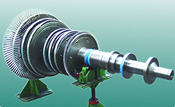OUR LOCATIONS
We can provide our services to power plants worldwide
Bradenton, Florida
941 - 527 - 6196
941 - 755 - 5229 (FAX)
Milwaukee, Wisconsin
414 - 698 - 5644
|

A BRIEF BALANCING HISTORY
and THE NEED FOR AN IMPROVED BALANCING METHOD
Rotor balancing in high speed balancing facilities is more a trade than an engineering activity. The need for balancing became evident in the times when rotors were primarily rigid and treated in theory as a rotating beam. Being highly rigid, any mass eccentricity was simply equated as “unbalance”, much in the same manner as balancing a low speed fan. These rotors were usually balanced on a low-speed balancing machine using two conveniently located balancing planes. With the advent of somewhat more flexible rotors running above the first and second critical speed, modal balancing was developed as a way of counteracting the amplified bending responses seen at these critical speeds.
Over time, as rotating machines were designed for higher efficiency, generator rotors in particular were designed to be ever more slim and flexible. Today, generator rotors are designed to operate far above the first critical speed, nearly always above the second, and very often near or above the third (or first flexural mode). However, in the rotor balancing service industry, the theory and approach hasn’t really changed much in 70+ years, even while rotor design has. With added rotor flexibility, the theory that worked for older, rigid rotors, no longer accurately represents the dynamic behavior in all cases. Additionally, with the aging of power plants, an ever increasing percentage of rotors in operation have notable bows, eccentricities, or other defects. In particular, generator rotors with “significant” mass eccentricity, operating above the second or third critical encounter the greatest set of difficulties if treated using the conventional, standard theory and approach.
Most rotordynamics specialists and balancers follow the traditional approach that considers all vibration as modal unbalance responses (as a bending deflection caused by centrifugal force). The standard approach uses the measured phase lag angle and focuses on angular placement of balancing weights to minimize the displacements, through influence coefficients and modal balancing, or some other hybrid balancing method. However, the standard approach most often neglects or misidentifies the rigid mode responses originating from distributed eccentricities, and only attempts to “balance” them simultaneously and incidentally while focusing on reducing modal displacement responses at critical speeds.
A debate arose in the balancing industry nearly 40 years ago between two balancing approaches, one driven by Bishop, who championed the “N-method”, and the other from Kellenberger, Federn and Schenck, who pushed for the “N+2 method”. Bishop’s N-method was designed around balancing newly manufactured rotors, and focused on solving modal displacement responses at the bearings, primarily in high speed balancing facilities. This method was effective, as long as the rotor body was essentially concentric, and because it was applied to newly manufactured rotors, rigid mode responses from rotor eccentricities were not a problem. The N+2 method was designed to additionally consider rigid mode responses from mass eccentricities, solving those first using 2 planes, considering the entire rotor as a single rigid beam, following the theory that any truly rigid beam can be balanced in any two balancing planes. This method proved much more effective in handling rotors in the service industry, with some mass eccentricity present. However, the N+2 method still falls short for highly flexible generator rotors, since the rotor does not behave as a rigid beam, even at relatively low speed.
An additional problem with both methods is in failing to consider that a highly eccentric rotor rotates about its geometric axis below the first system critical, but around its mass axis at speeds above the critical. All balancing performed at-speed, above the first critical, acts to balance the rotor around its mass axis, and not the geometric axis that the rotor will be constrained to when coupled in the field. Both the N-method, and to a lesser extent, the N+2 method, end up distorting the rotor in an effort to “push and bend” the geometric axis of the rotor into the mass axis while balancing above the first critical, dynamically distorting the rotor at speed. This creates internal moments and stresses in the rotor, and often leads to high bearing forces once reinstalled in an operating machine. Very often this condition also results in the rotor becoming sensitive to changes in load, exhibiting a rise in vibrations proportional to applied torque.
These problems are evident in practice quite frequently. All turbine-generator rotors at power plants must go through periodic inspections or rework, usually done during a planned scheduled outage. However, in many cases, after repair, and even after high-speed balancing in a balancing facility, dynamic performance after reinstallation is subpar, requiring further “field balancing” to enable operation of the unit. And even then, despite the added efforts, time and cost, field balancing is not fully successful, and often leads to a forced, mediocre compromise of what is “tolerable”, between bearing forces and rotor displacement amplitudes at critical speeds. The reason for this lies in the lack of understanding of the true physical events occurring on an elastic (flexible) rotor with inherent “significant” body eccentricity, during acceleration.
For a rotor to be truly balanced for operation in the field, two main conditions must be met. First, it must not be distorted by balancing weights at any speed, and second, it must be balanced around its geometric axis at all speeds. To assure this condition is met, Z-R Consulting developed the 2N+1 balancing method, based on principles from Finite Element modeling, to address and counteract the dynamic response of highly flexible, eccentric rotors, allowing any bowed or eccentric rotor to be efficiently and reliably balanced for operation.
|